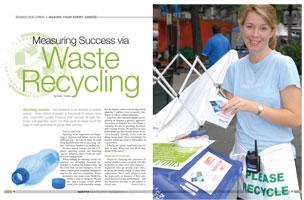
 Sporting events - from footraces to fan festivals to football games - draw millions of people to thousands of venues every year. Organizers usually measure their success by gate revenues and spectator count, but they could as easily count the bags of trash generated to gauge their success.
Sporting events - from footraces to fan festivals to football games - draw millions of people to thousands of venues every year. Organizers usually measure their success by gate revenues and spectator count, but they could as easily count the bags of trash generated to gauge their success.
That is, until now.
Sporting event organizers are beginning to measure and define success in a different way - by tons of waste diverted from landfills and sent to recycling centers. And those numbers are adding up.
In cities across Europe and the U.S., major sporting events are enacting "green" initiatives that re-write the rules on event management.
When bidding for sporting events, organizers are including thorough approaches to creating low-impact events. All the 2016 bids for the Olympics, for instance, touted green programs designed to impress the selection committee. Tokyo promised a zero waste event, Madrid included a plan to promote bicycle use, and Chicago would power events sites with renewable energy. Rio de Janeiro, which won the bid, will be planting 3 million trees in nearby rainforests to off-set carbon emissions.
Likewise, fans and participants are beginning to demand a greener approach. According to Athletes for a Fit Planet, a company devoted to greening foot races and cycling events, 94 percent of race participants say they would choose an environmentally friendly event, with all things being equal. More surprisingly, 81 percent would pay more to participate in a green race.
Clearly, the 'green' trend looks like it's here to stay. What can you do to stay ahead of the curve?
Study Best Practices Begin by studying the practices of similar events. Create a network with like properties in other cities and countries - organizers who are several years into a program are usually happy to share their experiences. Most early adopters took the steps early on because of their personal passion for the environment - and are therefore anxious to get others to follow suit.
Begin by studying the practices of similar events. Create a network with like properties in other cities and countries - organizers who are several years into a program are usually happy to share their experiences. Most early adopters took the steps early on because of their personal passion for the environment - and are therefore anxious to get others to follow suit.
Anheuser Busch was one such early adopter. "We put out millions of containers a year," says Robert Thoele, region manager for Anheuser Busch Recycling. "The company decided years ago that we have a responsibility to encourage recycling. If a sports property that uses our product asks for help, we try to get involved."
Categorize Your Objectives
Recycling cans and bottles is only the beginning. Your sustainability efforts should fall into four areas of concern: Waste Management, Community Impact, Transportation and Energy.
The three "R's" of Waste Management are Reduce, Reuse and Recycling. Your goal is to reduce the amount of waste going into a landfill. Waste can be reduced by purchasing bulk items with less packaging, or composting organic waste. Reuse can include collecting reusable timing chips at a foot race or designing signage for multi-year use. Recycling can include not only bottles and cans, but mulching eco-friendly signs after the event.
Community Impact refers to the impact your event has on the environment, especially fragile areas such as parks and greenways. Organizers can install fences and tree bark to limit impact from trampling grass and other sensitive areas.
Your Transportation plan can be designed for environmentally friendly measures as well. Providing incentives to spectators who use public transport can lead to behavioral changes that last forever. Special plans to promote bike use or web-based carpooling registration can lower your carbon emission impact, as well as utilizing hybrid bus technology for your shuttles.
Energy reduction is the final category. This can range from electing not to use air conditioning or heat during an indoor event set-up, to using alternative energy to fuel your events. Energy reduction can also be achieved by purchasing carbon off-sets. Organizations like Native Energy will take your event data and translate the information into a dollar figure, which you can donate to alternative energy sources.
Create a Green Team
Teamwork is the real key to creating and implementing an environmental plan.
 "There is no doubt that once we leave the stadium doors, we have to rely on other team members," says Scott Paul, stadium operations manager of the Carolina Panthers. "We've been recycling in the stadium since our third season. When we decided to make it happen in the tailgating lots around Uptown Charlotte, we knew it would take cooperation from many different organizations."
"There is no doubt that once we leave the stadium doors, we have to rely on other team members," says Scott Paul, stadium operations manager of the Carolina Panthers. "We've been recycling in the stadium since our third season. When we decided to make it happen in the tailgating lots around Uptown Charlotte, we knew it would take cooperation from many different organizations."
To extend their recycling efforts outside the stadium, the Panthers partnered with Darlene Heater, vice president of Charlotte Center City Partners (CCCP), who is known as the person to push the recycling envelope with regard to citywide events.
"To introduce tailgating recycling, we pulled together a consortium of partners, including CCCP, the City of Charlotte, Keep Mecklenburg(County) Beautiful, the parking lot operators and Bojangles and Coca- Cola," says Heater. "No one entity could have accomplished alone what we've been able to do together."
The tailgate recycling program debuted in 2009 and has exceeded their expectations. Originally hoping to divert 20 percent of trash from the landfill to recycling, organizers now say they are almost double that, to nearly 40 percent.
"Qualcomm Stadium in San Diego has implemented tailgating recycling as well," says Heater. "But the difference there is that they own and operate their lot. We had to get the parking lot operators on board to train their attendants to distribute the recycling bags. Once the consumer understands the system, they want to do the right thing."
Educate and Communicate
No greening effort will be successful without educating your staff and volunteers, and communicating to your attendees.
"When we decided to introduce recycling to the Quail Hollow Championship, I knew we had to educate the rest of the staff on how serious we were," says Tony Shuster, head of operations for the PGA tournament. "When we started with cardboard recycling, it was difficult to get everyone on board. But once they saw me diving in the dumpster at the end of the day to pull out cardboard, they got the message." Today, they recycle seven to eight tons of cardboard each year.
The implementation of your program depends on changing human behavior, which is not a particularly easy thing to do. What makes it possible is education and communication. The entire Carolina Panthers tailgate program hinges on the parking lot attendants responsible for handing out recycling bags. In the end, if the motorists don't get their bags, the bottles and cans don't get recycled.
 Training your employees and volunteers to implement your program is essential. So, to, is communicating the message to your attendees. Your communications plan should include signage, volunteer buttons or aprons, and programs emblazoned with your green message. Team up with a green media sponsor for public service announcements prior to your event, and program your facility message system to get the particulars about your efforts directly to your attendees.
Training your employees and volunteers to implement your program is essential. So, to, is communicating the message to your attendees. Your communications plan should include signage, volunteer buttons or aprons, and programs emblazoned with your green message. Team up with a green media sponsor for public service announcements prior to your event, and program your facility message system to get the particulars about your efforts directly to your attendees.
Measure, Measure, Measure
Several years ago, measuring results of greening programs was difficult, since they were just being initiated. Now, more and more operators are partnering with their recycling centers and other service providers to help track the outcome. Every organization should have a system of measurement to assess success in every category, including tons of land-fill diverted waste.
Less common, but as important, is to measure one's perceptions of your event as it relates to your greening program. A simple exit poll can determine if your message about recycling is getting out, and if they have a more positive impression of your event because of it. This is especially helpful when budgeting for expenditures in future years - if you can prove a business case, management is more likely to ramp up your program.
Revise and Repeat
After each event or season, you should analyze your data, convene your greening partners and begin discussing how to improve outcome for the coming year. Review what your peers are doing and resolve to raise the bar in the future. You'll find that the more team members you involve, the more ideas they'll bring to the table.
With a well-implemented plan, your recycling numbers will soar, your carbon footprint will shrink, volunteers will become enthused and your attendees will become more loyal.
And isn't that a better way to measure your success?

